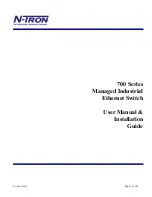
44-59
Catalyst 4500 Series Switch, Cisco IOS Software Configuration Guide - Cisco IOS XE 3.9.xE and IOS 15.2(5)Ex
Chapter 44 Configuring Quality of Service
Configuring QoS on a Standalone Supervisor Engine 6-E/6L-E or Supervisor Engine 7-E/7L-E/8-E
Marking Statistics
The marking statistics indicate the number of packets that are
marked
.
For unconditional marking, the
classification entry
points to an entry in the marking action table that in
turn indicates the fields in the packet that are marked. Therefore, the classification statistics by itself
indicates the unconditional marking statistics.
For a conditional marking using policer, provided the policer is a packet rate policer, you cannot
determine the number packets marked because the policer only provides byte statistics for different
policing results.
Shaping, Sharing (Bandwidth), Priority Queuing, Queue-limiting and DBL
The Catalyst 4500 series switch supports the Classification-based (class-based) mode for transmit queue
selection. In this mode, the transmit queue selection is based on the Output QoS classification lookup.
Note
Only output (egress) queuing is supported.
The supervisor engine supports 8 transmit queues per port. Once the forwarding decision has been made
to forward a packet out a port, the output QoS classification determines the transmit queue into which
the packet needs to be enqueued.
By default, without any service policies associated with a port, there are two queues (a control packet
queue and a default queue) with no guarantee as to the bandwidth or kind of prioritization. The only
exception is that system generated control packets are enqueued into control packet queue so that control
traffic receives some minimum link bandwidth.
Queues are assigned when an output policy attached to a port with one or more queuing related actions
for one or more classes of traffic. Because there are only eight queues per port, there can be at most eight
classes of traffic (including the reserved class, class-default) with queuing action(s). Classes of traffic
that do not have any queuing action are referred to as
non-queuing
classes. Non-queuing class traffic
ends up using the queue corresponding to class class-default.
When a queuing policy (a policy with queuing action) is attached, the control packet queue is deleted
and the control packets are enqueued into respective queue per their classification. An egress QoS class
must be configured to match IP Precedence 6 and 7 traffic, and a bandwidth guarantee must be
configured.
Dynamic resizing of queues (queue limit class-map action) is supported through the use of the
queue-limit
command. Based on the chassis and line card type, all eight queues on a port are configured
with equal queue size.
Shaping
Shaping enables you to delay out-of-profile packets in queues so that they conform to a specified profile.
Shaping is distinct from policing. Policing drops packets that exceed a configured threshold, whereas
shaping
buffers
packets so that traffic remains within a given threshold. Shaping offers greater
smoothness
in handling traffic than policing. You enable average-rate traffic shaping on a traffic class
with the
policy-map
class configuration command.
The supervisor engine supports a range of 32kbps to 10 gbps for shaping, with a precision of
approxi/- 0.75 per cent.
Summary of Contents for Catalyst 4500 Series
Page 2: ......
Page 4: ......
Page 2086: ...Index IN 46 Software Configuration Guide Release IOS XE 3 9 0E and IOS 15 2 5 E ...
















































